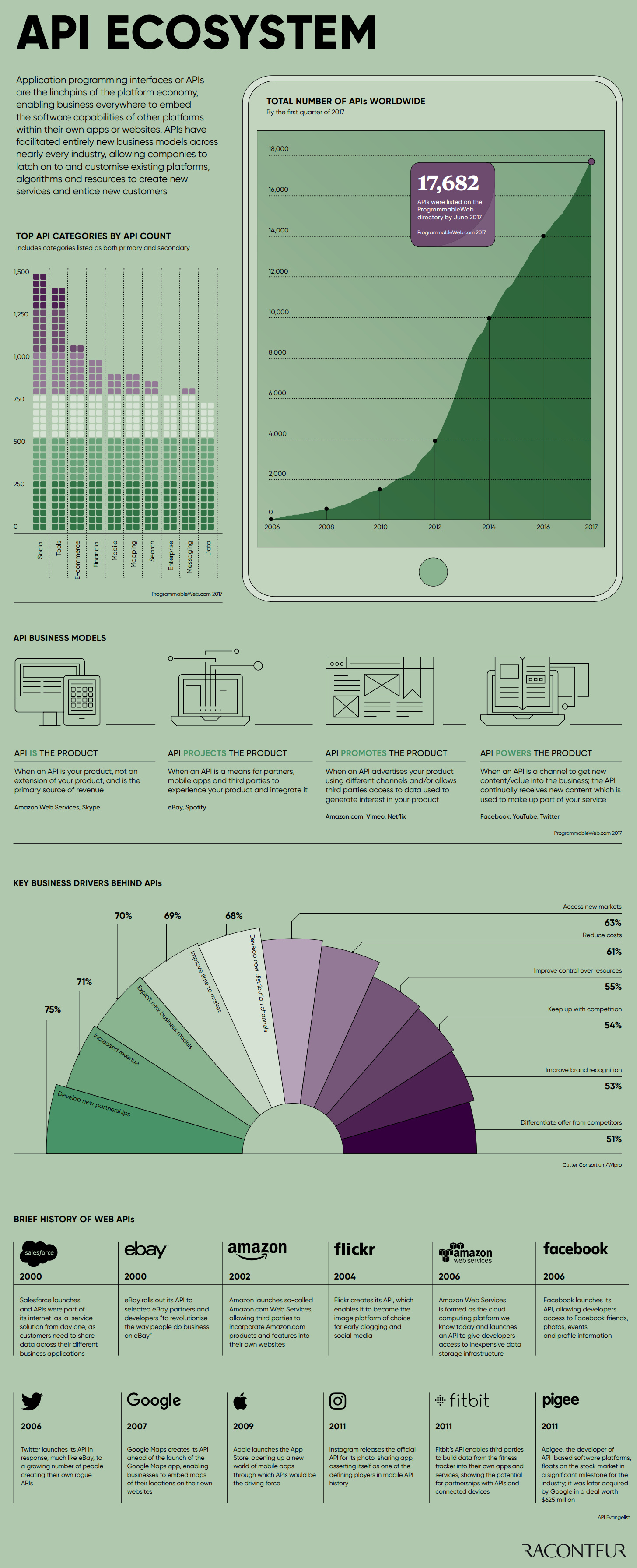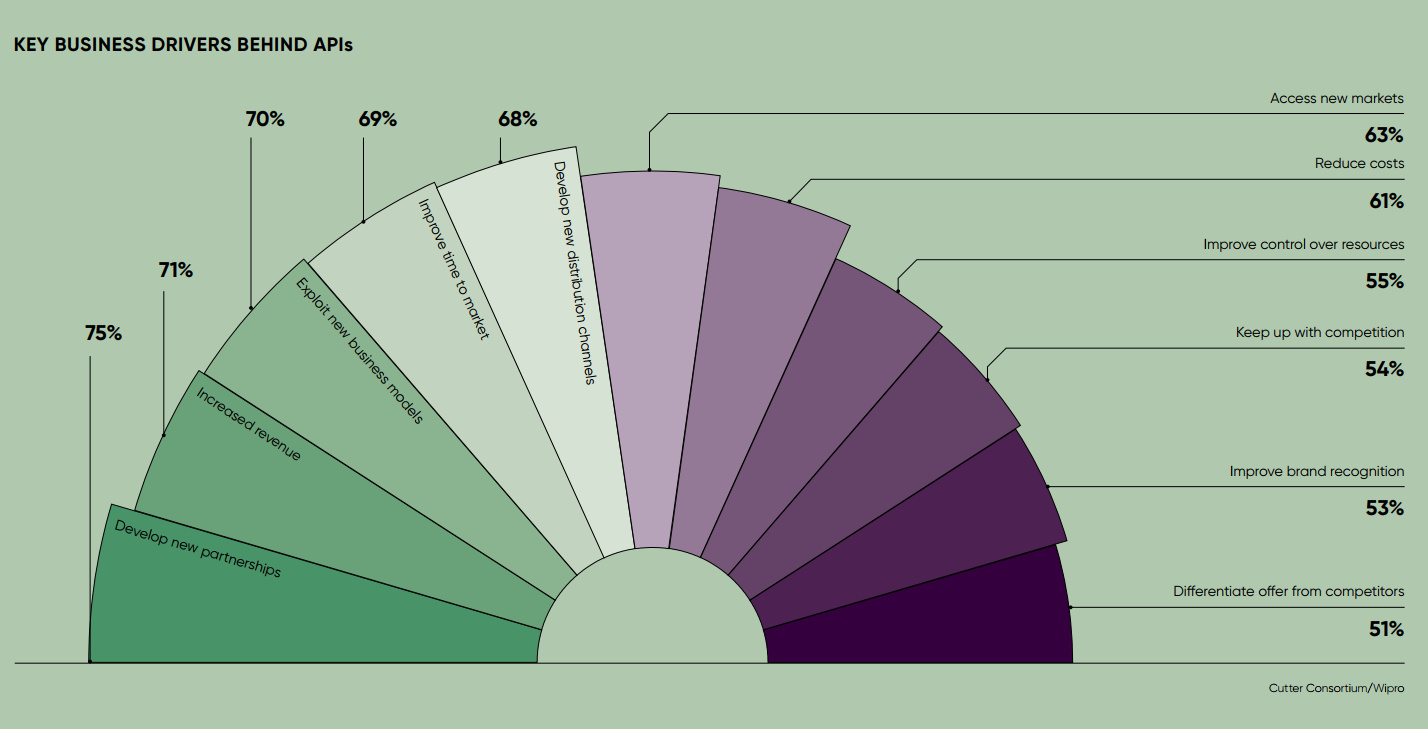Technology
APIs: The Unsung Heroes of our Connected World

APIs: The Unsung Heroes of our Connected World
Connected digital platforms improve our lives in many ways. We use social network profiles to log onto apps and websites, third-party payment systems while online shopping, and we share our activity data from devices like Fitbit. How do all these platforms work together so seamlessly?
It’s all done through a technology known as Application Programming Interfaces (APIs).
As today’s infographic from Raconteur demonstrates, thousands of APIs are allowing companies to work together and share data in powerful ways.
Here are the four main business models that use APIs:
| Business Model | Description | Example Companies |
|---|---|---|
| API is the Product | The API itself is the primary source of revenue | Amazon Web Services, Skype |
| API Projects the Product | Allows partners and third-parties to integrate | eBay, Spotify |
| API Promotes the Product | Advertises your product, shares data to generate interest | Amazon, Vimeo, Netflix |
| API Powers the Product | A channel to drive new data / content onto platform | Facebook, YouTube, Twitter |
How Do APIs Work?
An API is essentially a messenger that delivers a request to the provider you’re requesting it from, and then delivers the response back to you. Here are some of real-world examples:
Travel Sites – If you are using a travel site (e.g. Travelocity, Expedia), APIs are what allow that site to “talk to” airline databases to generate results to your query. Without an API, there would be no way for travel websites to aggregate flight and hotel quotes in real time.
Advertising – If you are a marketer, you are likely using a service to manage your campaigns in one place. Social platforms like Twitter have an API for ads that allows for integration between their platform and selected advertising solutions. This keeps marketers from having to log in to every single social website to manage their campaigns.
Apps – Say you open up a weather app on your iWatch. That app needs to get its information from a source, typically a website like weather.com. Apple could scrape information off the website, but APIs allow a more standardized, stable approach for requesting information. This way, weather.com can dictate the structure of information requests to facilitate the seamless flow of information.
Next time you’re cursing the weather forecast on your phone, remember the hero who fetched the information for you.
Technology
All of the Grants Given by the U.S. CHIPS Act
Intel, TSMC, and more have received billions in subsidies from the U.S. CHIPS Act in 2024.

All of the Grants Given by the U.S. CHIPS Act
This was originally posted on our Voronoi app. Download the app for free on iOS or Android and discover incredible data-driven charts from a variety of trusted sources.
This visualization shows which companies are receiving grants from the U.S. CHIPS Act, as of April 25, 2024. The CHIPS Act is a federal statute signed into law by President Joe Biden that authorizes $280 billion in new funding to boost domestic research and manufacturing of semiconductors.
The grant amounts visualized in this graphic are intended to accelerate the production of semiconductor fabrication plants (fabs) across the United States.
Data and Company Highlights
The figures we used to create this graphic were collected from a variety of public news sources. The Semiconductor Industry Association (SIA) also maintains a tracker for CHIPS Act recipients, though at the time of writing it does not have the latest details for Micron.
| Company | Federal Grant Amount | Anticipated Investment From Company |
|---|---|---|
| 🇺🇸 Intel | $8,500,000,000 | $100,000,000,000 |
| 🇹🇼 TSMC | $6,600,000,000 | $65,000,000,000 |
| 🇰🇷 Samsung | $6,400,000,000 | $45,000,000,000 |
| 🇺🇸 Micron | $6,100,000,000 | $50,000,000,000 |
| 🇺🇸 GlobalFoundries | $1,500,000,000 | $12,000,000,000 |
| 🇺🇸 Microchip | $162,000,000 | N/A |
| 🇬🇧 BAE Systems | $35,000,000 | N/A |
BAE Systems was not included in the graphic due to size limitations
Intel’s Massive Plans
Intel is receiving the largest share of the pie, with $8.5 billion in grants (plus an additional $11 billion in government loans). This grant accounts for 22% of the CHIPS Act’s total subsidies for chip production.
From Intel’s side, the company is expected to invest $100 billion to construct new fabs in Arizona and Ohio, while modernizing and/or expanding existing fabs in Oregon and New Mexico. Intel could also claim another $25 billion in credits through the U.S. Treasury Department’s Investment Tax Credit.
TSMC Expands its U.S. Presence
TSMC, the world’s largest semiconductor foundry company, is receiving a hefty $6.6 billion to construct a new chip plant with three fabs in Arizona. The Taiwanese chipmaker is expected to invest $65 billion into the project.
The plant’s first fab will be up and running in the first half of 2025, leveraging 4 nm (nanometer) technology. According to TrendForce, the other fabs will produce chips on more advanced 3 nm and 2 nm processes.
The Latest Grant Goes to Micron
Micron, the only U.S.-based manufacturer of memory chips, is set to receive $6.1 billion in grants to support its plans of investing $50 billion through 2030. This investment will be used to construct new fabs in Idaho and New York.
-

 Energy1 week ago
Energy1 week agoThe World’s Biggest Nuclear Energy Producers
-

 Money2 weeks ago
Money2 weeks agoWhich States Have the Highest Minimum Wage in America?
-

 Technology2 weeks ago
Technology2 weeks agoRanked: Semiconductor Companies by Industry Revenue Share
-

 Markets2 weeks ago
Markets2 weeks agoRanked: The World’s Top Flight Routes, by Revenue
-

 Countries2 weeks ago
Countries2 weeks agoPopulation Projections: The World’s 6 Largest Countries in 2075
-

 Markets2 weeks ago
Markets2 weeks agoThe Top 10 States by Real GDP Growth in 2023
-

 Demographics2 weeks ago
Demographics2 weeks agoThe Smallest Gender Wage Gaps in OECD Countries
-

 United States2 weeks ago
United States2 weeks agoWhere U.S. Inflation Hit the Hardest in March 2024














